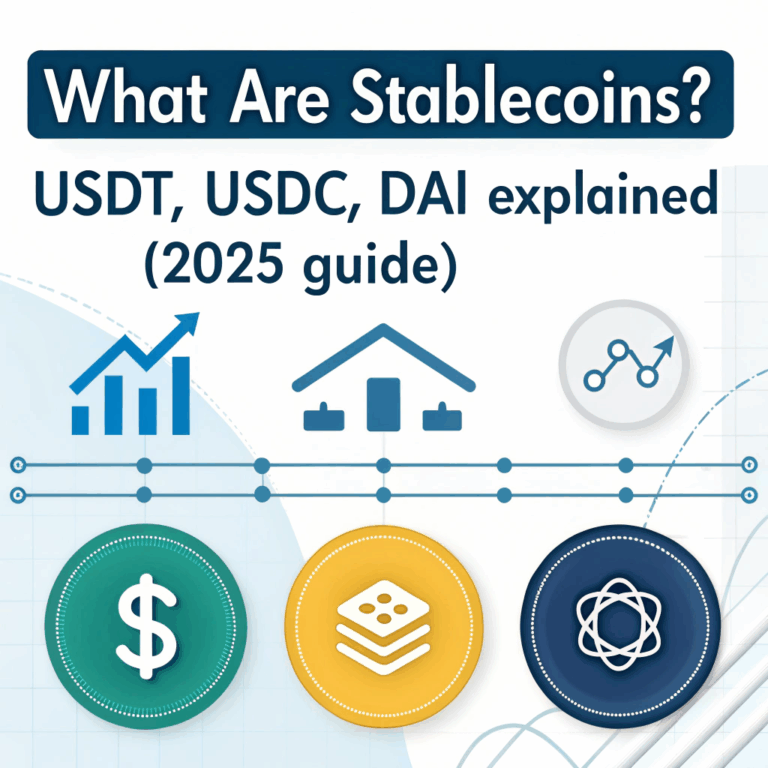Proof of Work vs. Proof of Stake – Key Differences Explained (2025)

Introduction
At the heart of every blockchain is a consensus mechanism — a way for network participants to agree on what’s true. Two major methods dominate the crypto world: Proof of Work (PoW) and Proof of Stake (PoS). In this article, we break down how they work, why they matter, and how they’re shaping crypto in 2025.
What Is a Consensus Mechanism?
A consensus mechanism is the process used by a blockchain network to validate transactions and add new blocks to the chain without a central authority.
It ensures:
- Transactions are legitimate
- No double spending occurs
- The network agrees on one version of the truth
What Is Proof of Work (PoW)?
PoW is the original blockchain consensus mechanism, introduced by Bitcoin. In PoW:
- Miners compete to solve complex math puzzles
- The first to solve the puzzle adds the next block
- The miner is rewarded with new coins (block reward)
Key Features:
- Requires specialized hardware (ASICs, GPUs)
- Very secure but energy-intensive
- Used by Bitcoin, Litecoin, Dogecoin, etc.
What Is Proof of Stake (PoS)?
PoS is a newer, more energy-efficient consensus method. In PoS:
- Validators are chosen to create new blocks based on how much crypto they “stake” (lock up)
- The more you stake, the higher your chances of being selected
- Validators earn rewards for validating transactions
Key Features:
- No mining required
- Lower energy use
- Used by Ethereum 2.0, Cardano, Solana, and others
Key Differences Between PoW and PoS
| Feature | Proof of Work (PoW) | Proof of Stake (PoS) |
|---|---|---|
| Hardware Needed | Yes (mining rigs) | No |
| Energy Consumption | High | Low |
| Entry Barrier | Expensive hardware | Requires staking crypto |
| Speed | Slower | Faster |
| Security | Proven over time | Strong but newer |
| Example Coins | Bitcoin, Dogecoin | Ethereum, Cardano, Solana |
Energy Consumption: PoW vs PoS
- PoW networks consume massive electricity — often more than small countries
- PoS networks cut energy use by 99%+
That’s why Ethereum transitioned from PoW to PoS in 2022 — part of a global push for greener blockchain technology.
Security Comparison
- PoW: Security comes from the cost of mining — it’s expensive to attack
- PoS: Security comes from economic stake — validators risk losing coins if they cheat (slashing)
Both are secure, but PoW is more battle-tested; PoS is more scalable.
Decentralization and Accessibility
- PoW: Centralizes over time due to expensive mining equipment
- PoS: More accessible — anyone can participate by staking, but wealthier stakers have more influence
In 2025, many PoS systems are improving fairness through random validator selection and caps.
Examples of Coins Using PoW and PoS
Proof of Work Coins:
- Bitcoin (BTC)
- Litecoin (LTC)
- Dogecoin (DOGE)
- Monero (XMR)
Proof of Stake Coins:
- Ethereum (ETH)
- Cardano (ADA)
- Solana (SOL)
- Polkadot (DOT)
- Tezos (XTZ)
Which Is Better in 2025?
There’s no clear winner — it depends on the goals:
- PoW is ideal for networks prioritizing long-term security and decentralization (like Bitcoin)
- PoS is better for fast, scalable, and eco-friendly blockchains (like Ethereum and Solana)
Most new projects in 2025 prefer PoS or hybrid models for performance and sustainability.
Hybrid Models and the Future of Consensus
Some blockchains use a combination of PoW and PoS, or entirely new models like:
- DPoS (Delegated Proof of Stake)
- LPoS (Leased Proof of Stake)
- Proof of Authority (PoA) for private networks
- Zero-knowledge proofs (ZK-rollups) for Layer 2 scalability
The future likely includes custom consensus models optimized for specific use cases.
FAQ
Why did Ethereum switch to PoS?
To reduce energy usage and enable scaling via sharding and Layer 2 tech.
Is PoS less secure than PoW?
Not necessarily. It’s newer but has strong cryptographic protection and economic penalties for bad behavior.
Can I mine with Proof of Stake?
No. PoS doesn’t involve mining — you earn by staking, not solving puzzles.
Which one is better for beginners?
PoS is easier to participate in — you can stake using exchanges or wallets with just a few clicks.
Conclusion
Proof of Work and Proof of Stake are two powerful approaches to securing blockchain networks. In 2025, PoW continues to anchor Bitcoin, while PoS leads innovation in energy efficiency and accessibility. Understanding both helps you navigate the evolving crypto landscape — whether you’re investing, building, or just learning





